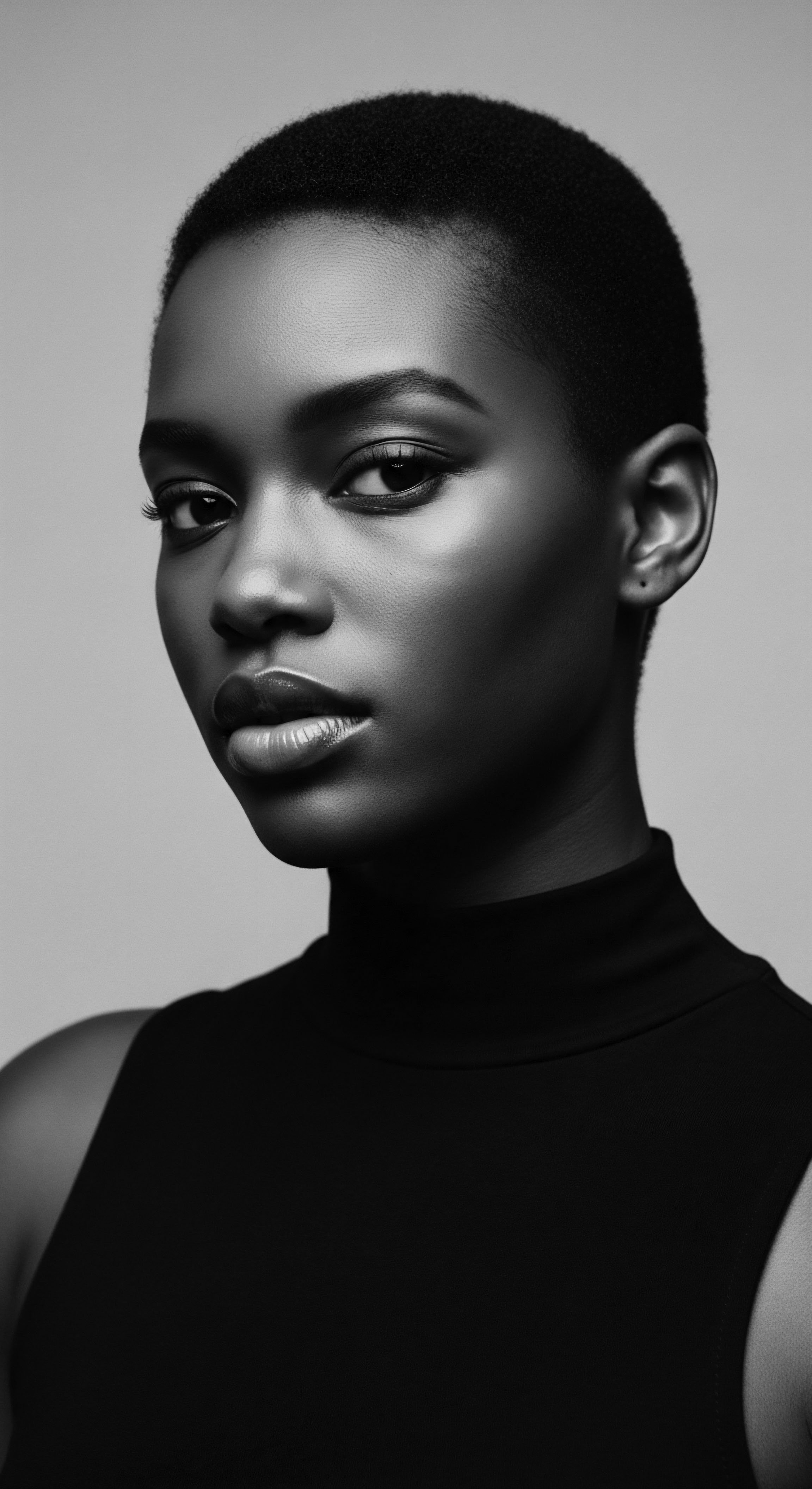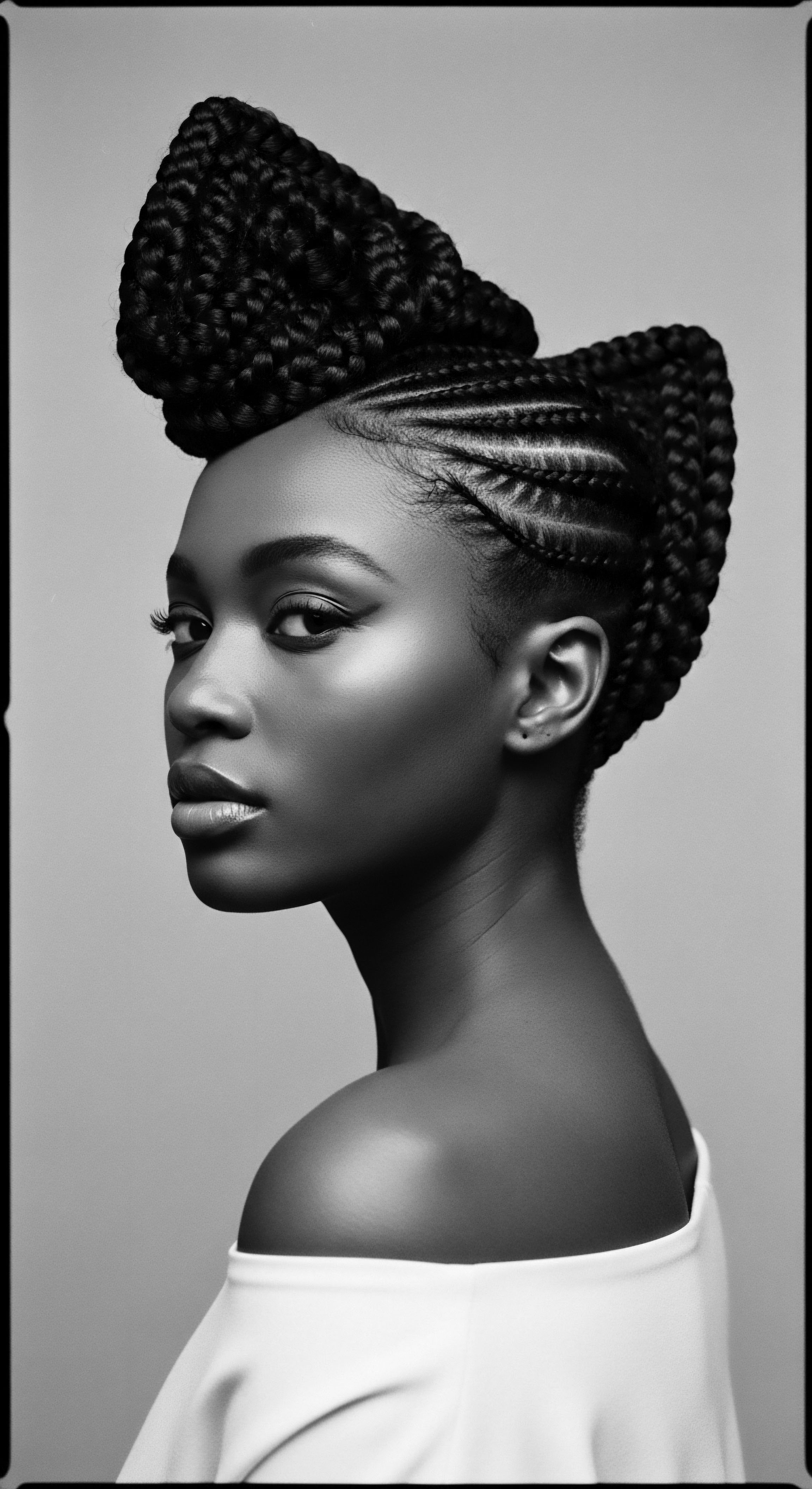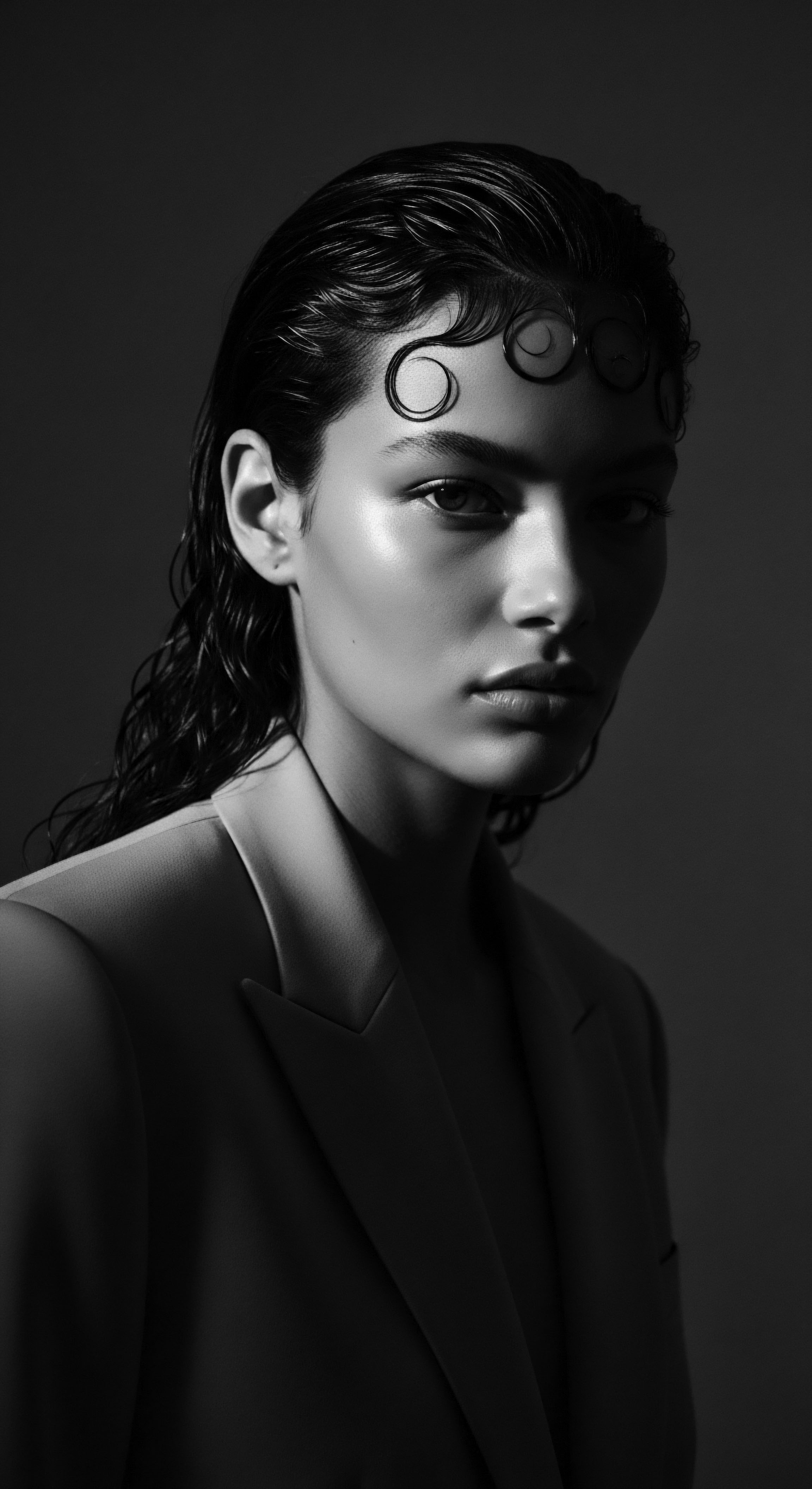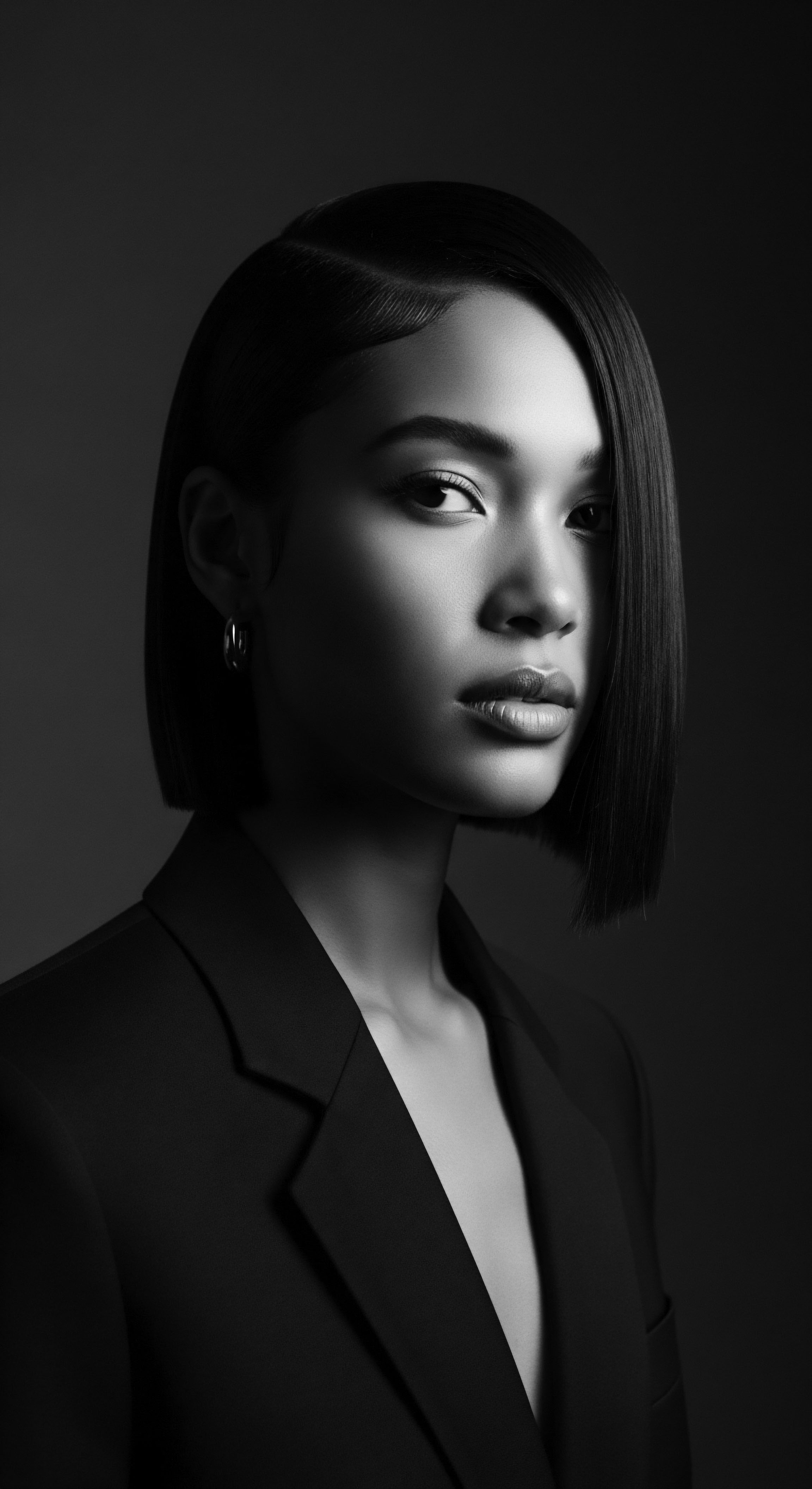
Fundamentals
The concept we approach as ‘Egyptian Hair’ within Roothea’s ‘living library’ extends far beyond a simple anatomical description of ancient tresses preserved through millennia. It is, at its most fundamental, a vibrant echo of ancestral practices, a testament to the profound connection between human identity and the very strands that crown our being. This initial exploration seeks to delineate the elemental significance of hair in ancient Egypt, setting the stage for a deeper understanding of its enduring resonance within the expansive realm of textured hair heritage.
Consider the Nile, lifeblood of an ancient civilization, nourishing the land and its people. In a similar vein, hair, for the Egyptians, was a conduit of life, an expression of status, purity, and spiritual alignment. The care lavished upon it was not merely cosmetic; it was a sacred ritual, a daily reaffirmation of one’s place in the cosmic order.
The earliest records, etched into stone and papyrus, depict a people deeply invested in their hair’s presentation, recognizing its inherent power and communicative capacity. This initial perception provides a foundational understanding of ‘Egyptian Hair’ as a historical and cultural artifact, rather than a mere biological specimen.
‘Egyptian Hair’ signifies a profound legacy of ancestral hair practices, revealing the ancient civilization’s deep reverence for hair as an extension of identity and spiritual well-being.

Ancient Threads, Enduring Meanings
From the earliest dynasties, the appearance of hair held considerable social weight. It communicated a person’s station, their cleanliness, and even their spiritual state. While popular imagery often conjures images of smooth, dark hair, archaeological discoveries and artistic representations reveal a far more diverse spectrum of hair textures and styles among the populace. This diversity speaks to the rich ethnic tapestry of ancient Egypt, a crossroads of African and Near Eastern cultures, where varying hair types, from tightly coiled to wavy, were present and meticulously cared for.
The ancient Egyptians developed an impressive array of tools and concoctions to maintain their hair. Combs crafted from wood and ivory, hairpins fashioned from bone and metal, and mirrors of polished bronze were commonplace items, indicating a sophisticated approach to personal grooming. The precise application of oils and unguents, often scented with fragrant botanicals, served not only to soften and condition the hair but also to protect the scalp from the harsh desert sun. These practices, though ancient, carry an unmistakable whisper of the intuitive care regimens that textured hair demands even today.
- Combs ❉ Essential for detangling and styling, crafted with varying tooth widths to accommodate different hair textures.
- Oils ❉ Derived from plants such as castor, moringa, and almond, used for conditioning, moisturizing, and imparting shine.
- Wigs ❉ Elaborate constructions of human hair or plant fibers, worn for protection, hygiene, and social display, signifying status and often serving ceremonial purposes.
- Hairpins ❉ Ornate or simple, used to secure styles and adornments, reflecting personal aesthetic and social standing.

The Delineation of Care
The understanding of ‘Egyptian Hair’ also involves the deliberate acts of preservation and adornment that extended beyond life itself. Mummification rituals often included the meticulous preparation of hair, sometimes styled, braided, or even covered with wigs, signifying the belief that the physical form, including its crowning glory, would accompany the spirit into the afterlife. This meticulous attention to hair, even in death, underscores its profound meaning within their worldview. The surviving examples of ancient Egyptian hair, remarkably preserved through arid conditions, offer a tangible link to these long-past civilizations and their deep respect for the physical self.
This initial look at ‘Egyptian Hair’ begins to unearth its fundamental character ❉ a symbol of health, status, and spiritual connection, deeply intertwined with the daily rituals and grand beliefs of an ancient civilization. The simple meaning here is that ‘Egyptian Hair’ is not merely a biological feature but a cultural artifact, a living archive of ancient practices and enduring values that resonate with the heritage of hair care across time.

Intermediate
Moving beyond the foundational insights, an intermediate understanding of ‘Egyptian Hair’ calls for a deeper consideration of its significance within the broader spectrum of textured hair heritage. This involves discerning the nuances of ancient Egyptian hair care practices, their underlying intentions, and how these ancestral traditions speak to the experiences of Black and mixed-race individuals today. The ancient Egyptians, a people of diverse origins, navigated a spectrum of hair textures, and their ingenious methods offer valuable lessons for contemporary care.
The elaborate hair regimens of ancient Egypt were not merely about aesthetics; they were deeply interwoven with hygiene, health, and spiritual belief. The arid climate necessitated practices that preserved moisture and protected the scalp from sun and sand. This environmental context shaped their approach to hair care, prompting the utilization of ingredients and techniques that prioritized hydration and resilience. Such an understanding reveals a pragmatic yet reverent relationship with hair, a balance between practical need and symbolic expression.

Ancestral Wisdom in Practice
The specific application of oils and unguents stands as a powerful example of this ancestral wisdom. Ingredients like castor oil, known for its conditioning properties, and moringa oil, revered for its protective qualities, were integral to their daily routines. These botanical extracts were not randomly chosen; their efficacy was likely discovered through generations of observation and experimentation, a testament to an early form of ethnobotanical knowledge. The process of warming these oils, often infused with fragrant resins like frankincense or myrrh, before application, would have enhanced their absorption and spread, mirroring practices still cherished in traditional hair oiling rituals globally.
| Ancient Ingredient Castor Oil |
| Traditional Use in Egypt Used to moisturize hair, promote growth, and treat scalp conditions. |
| Contemporary Relevance for Textured Hair A widely used ingredient in Black hair care for strengthening strands, moisturizing, and supporting scalp health, often for thicker, coily textures. |
| Ancient Ingredient Moringa Oil |
| Traditional Use in Egypt Applied for its protective qualities against sun and dryness, and for its nourishing properties. |
| Contemporary Relevance for Textured Hair Valued for its antioxidant properties and light texture, providing conditioning and protection without weighing down textured hair. |
| Ancient Ingredient Almond Oil |
| Traditional Use in Egypt Utilized as a softening agent and to impart shine to hair. |
| Contemporary Relevance for Textured Hair A popular emollient in modern hair care, providing moisture and reducing frizz for various textured hair types. |
| Ancient Ingredient Resins (Frankincense, Myrrh) |
| Traditional Use in Egypt Incorporated into hair unguents for fragrance, purification, and potential antimicrobial benefits. |
| Contemporary Relevance for Textured Hair Their aromatic and therapeutic properties are now appreciated in holistic hair care for scalp soothing and sensory experience. |
| Ancient Ingredient These ancient formulations demonstrate a timeless understanding of botanical efficacy, echoing through generations of textured hair care. |
The careful braiding and styling of hair, often into intricate patterns, also served multiple purposes. Beyond aesthetic appeal, these styles offered a measure of protection against environmental elements, minimizing breakage and tangling. This protective styling, whether through elaborate braids or the use of wigs, finds direct parallels in the protective styles prevalent in Black hair culture today, which safeguard delicate textured strands from manipulation and environmental stress. This continuity of practice across millennia underscores a shared wisdom in managing and preserving diverse hair textures.
The sophisticated hair care regimens of ancient Egypt, born from environmental necessity and spiritual conviction, reveal a timeless connection to modern textured hair practices.

Hair as a Communicator of Identity
The interpretation of ‘Egyptian Hair’ also requires acknowledging its powerful role as a visual language. Hair styles, adornments, and even the presence or absence of hair (as in the case of shaven heads for priests or during mourning) conveyed specific messages about social standing, religious devotion, marital status, and personal expression. This symbolic capacity of hair, its ability to communicate without words, remains a potent force within Black and mixed-race communities, where hair is often a profound statement of identity, heritage, and resistance. The ancient Egyptians understood this deeply, making hair a deliberate canvas for self-presentation.
The meticulousness observed in the preparation of wigs, often crafted from human hair or vegetable fibers, further illuminates this intermediate understanding. These wigs were not simply fashion accessories; they were sophisticated head coverings that offered both practical benefits, such as protection from lice and sun, and symbolic weight. The variety of wig styles, from short, tight curls to long, flowing locks, suggests an appreciation for diverse textures and forms, reflecting the varied natural hair types within their population. This historical context offers a powerful counter-narrative to modern perceptions that often marginalize or misrepresent textured hair.
The exploration of ‘Egyptian Hair’ at this level invites us to see beyond superficial appearances and recognize the profound ancestral knowledge embedded in ancient hair practices. It encourages a reflection on how these historical approaches continue to shape and inform our understanding of hair health, cultural identity, and the enduring legacy of care within textured hair communities. The significance of ‘Egyptian Hair’ thus broadens to encompass a living tradition, a continuous dialogue between past wisdom and present needs.

Academic
At the academic zenith, the precise delineation of ‘Egyptian Hair’ transcends mere historical description, asserting itself as a complex construct deeply rooted in anthropological inquiry, bioarchaeological evidence, and the socio-cultural dynamics of identity formation within ancient and contemporary contexts. This scholarly perspective posits ‘Egyptian Hair’ not as a singular hair type, but as a rich, multi-layered concept encompassing the diverse phenotypical expressions of hair within ancient Egyptian populations, the sophisticated material culture surrounding its care, and its profound semiotic role in conveying status, spiritual adherence, and ethnic belonging. It represents a crucible where elemental biology, environmental adaptation, and elaborate cultural practices converged to shape one of the earliest and most enduring traditions of hair reverence.
The academic understanding of ‘Egyptian Hair’ requires a rigorous examination of the bioarchaeological record. Analysis of mummified remains, often through advanced techniques such as scanning electron microscopy (SEM) and elemental analysis, reveals the microstructural characteristics of ancient Egyptian hair. These studies consistently demonstrate a wide range of hair shaft morphologies, including those characteristic of both straight/wavy and tightly coiled/kinky textures. This scientific validation dislodges any monolithic portrayal of ancient Egyptian hair, instead confirming the presence of diverse hair phenotypes reflective of the region’s historical position as a nexus of African, Near Eastern, and Mediterranean peoples.
For instance, a study by Nerlich et al. (2007) on ancient Egyptian hair samples confirmed the presence of diverse hair structures, including variations in cross-sectional shape, a key indicator of hair texture, reinforcing the idea that a single ‘Egyptian hair type’ is a misnomer. This empirical evidence is crucial for dismantling reductionist interpretations and for affirming the historical presence of textured hair within this ancient civilization.

The Delineation of Ancient Hair Science and Practice
The meticulous care afforded to hair in ancient Egypt points to an early, intuitive understanding of hair biology and chemistry. The use of specific oils and unguents, often rich in fatty acids and antioxidants, suggests an awareness of their protective and restorative properties. For example, the application of fatty substances derived from animals or plants (such as castor, moringa, and fenugreek) would have provided a occlusive barrier, reducing transepidermal water loss from the scalp and hair shaft, a vital strategy for maintaining moisture in arid environments. This ancestral knowledge, though not articulated in modern scientific terms, reflects a deep observational science of hair health, predating contemporary trichology by millennia.
The complex formulations found in archaeological contexts, often involving a mixture of oils, resins, and pulverized plant materials, indicate a sophisticated empirical pharmacology. These mixtures were likely designed to address specific concerns ❉ hair loss, dryness, scalp irritation, or simply to enhance luster and manageability. The presence of antimicrobial agents, such as myrrh or frankincense, in some hair preparations also points to an understanding of scalp hygiene and the prevention of dermatological issues. This comprehensive approach to hair and scalp wellness represents a significant historical contribution to the domain of personal care.
Furthermore, the societal infrastructure supporting these practices was extensive. Specialized barbers and wig makers were integral members of society, their skills highly valued. The creation and maintenance of elaborate wigs, which could be constructed from human hair, plant fibers, or even wool, required considerable technical expertise.
These wigs served not only as fashion statements but also as practical head coverings, protecting the natural hair and scalp from the elements, and as powerful symbols of social rank and ritual purity. The enduring quality of many of these artifacts, some still retaining their intricate styling, speaks volumes about the advanced techniques employed.
- Cross-Sectional Morphology ❉ Bioarchaeological studies indicate ancient Egyptian hair displayed a range of cross-sectional shapes, from round (common in straight hair) to oval or flattened (characteristic of wavy to coily textures), challenging the notion of a uniform hair type.
- Chemical Composition of Ancient Hair Products ❉ Analysis of residues on ancient combs and in cosmetic jars reveals the presence of plant-based oils, animal fats, and mineral pigments, signifying a sophisticated understanding of material properties for hair care.
- Hair as a Diagnostic Tool ❉ Ancient hair samples have provided insights into diet, disease, and environmental exposures, serving as a biological archive of individual and population health.
- Wig Construction Techniques ❉ The intricate methods used to construct wigs, involving knotting, weaving, and the application of beeswax or resin as styling agents, demonstrate a high level of craftsmanship and technical innovation.

Hair as a Cultural Semiotic System and Ancestral Legacy
Beyond its biological and material aspects, ‘Egyptian Hair’ functioned as a potent semiotic system, encoding and transmitting complex cultural messages. The shaven heads of priests and priestesses, for example, symbolized purity and devotion, distinguishing them from the general populace. Conversely, elaborate hairstyles and wigs, often adorned with gold, beads, and floral elements, denoted wealth, status, and participation in specific social rituals.
The very act of grooming became a performative ritual, a daily inscription of identity onto the body. This understanding is critical for comprehending the profound meaning of hair within the ancient Egyptian worldview.
The connection of ‘Egyptian Hair’ to textured hair heritage, particularly within Black and mixed-race experiences, is not merely analogical; it is a profound historical continuum. The diverse hair textures observed in ancient Egyptian populations reflect the indigenous African roots of the civilization, alongside migrations and interactions with neighboring regions. This historical reality provides a powerful ancestral anchor for individuals with textured hair today, affirming the long and celebrated history of diverse hair types within powerful and sophisticated African civilizations. The cultural significance placed on hair in ancient Egypt — its role in identity, spirituality, and social expression — finds echoes in the enduring traditions of Black hair care and styling across the diaspora.
The academic lens reveals ‘Egyptian Hair’ as a complex interplay of diverse biological textures, advanced ancient care practices, and a potent semiotic system that continues to resonate with textured hair heritage globally.
A particularly illuminating example of this deep connection lies in the persistence of specific hair care ingredients and philosophies. The reverence for natural emollients and botanicals, evident in ancient Egyptian unguents, is mirrored in the contemporary emphasis on natural oils and butters within textured hair care. This continuity suggests a deep, embodied knowledge passed down through generations, often outside formal written records. The intuitive understanding that certain plant extracts nourish and protect coily or kinky strands, for instance, represents an unbroken chain of ancestral wisdom, even if the precise scientific mechanisms were not then articulated.
The cultural impact of hair in ancient Egypt also offers insights into the psychological and social dimensions of hair in Black and mixed-race communities. In ancient Egypt, hair could be a source of pride, a symbol of power, and a canvas for artistic expression. This positive valuation stands in stark contrast to later periods of colonial influence where textured hair was often denigrated. By re-examining the ‘Egyptian Hair’ context, we gain a historical precedent for the celebration and affirmation of diverse hair textures, providing a powerful counter-narrative to Eurocentric beauty standards that have historically marginalized textured hair.
The meticulousness of ancient Egyptian hair practices, from intricate braiding to the creation of wigs, speaks to a deep appreciation for the artistry and protective qualities inherent in diverse hair textures. This historical perspective reinforces the understanding that sophisticated hair care for textured hair is not a modern invention but a legacy stretching back millennia.

Reflection on the Heritage of Egyptian Hair
As we draw our inquiry into ‘Egyptian Hair’ to a close, a profound sense of continuity settles upon us, like the fine dust of the desert settling on ancient monuments. The journey through its elemental biology, ancient practices, and socio-cultural significance reveals more than just historical facts; it unearths a living legacy, a resonant whisper from the past that speaks directly to the soul of every strand, particularly those of textured hair. This exploration is not merely an academic exercise; it is an act of remembrance, a re-connection to the deep wellspring of ancestral wisdom that shaped human interaction with hair for millennia.
The ‘Soul of a Strand’ ethos finds its profoundest expression in the story of ‘Egyptian Hair.’ Each meticulously preserved braid, each carefully concocted unguent, each artistic depiction of a coiffure, represents a deliberate act of care, a testament to the belief that hair was an extension of self, deserving of reverence and protection. This ancient perspective offers a powerful antidote to modern tendencies to view hair as a superficial adornment or a problem to be managed. Instead, it invites us to see hair as a sacred conduit, a repository of identity, and a continuous link to those who came before us.
For individuals with textured hair, the heritage of ‘Egyptian Hair’ is particularly poignant. It offers a powerful affirmation of the beauty and resilience of diverse hair types, tracing their lineage back to a civilization that celebrated and meticulously cared for them. The ingenious methods of moisture retention, protective styling, and scalp health, developed in response to environmental challenges, resonate deeply with the needs of textured hair today. This historical validation provides a foundation for pride, dispelling narratives that have historically marginalized or misunderstood the inherent magnificence of coily, kinky, and wavy hair.
The enduring significance of ‘Egyptian Hair’ lies in its capacity to inspire a renewed appreciation for ancestral practices. It encourages us to look beyond fleeting trends and reconnect with the timeless wisdom embedded in natural ingredients and holistic care rituals. The spirit of meticulous attention, of treating hair as a cherished part of one’s being, is a timeless gift from the past, a gentle invitation to honor our own strands with the same reverence. In this living library, ‘Egyptian Hair’ stands as a luminous entry, reminding us that the journey of hair care is a continuous dialogue between ancient wisdom and contemporary understanding, a testament to the unbroken lineage of care that binds us to our heritage.

References
- Nerlich, A. G. et al. (2007). Hair of the Ancient Egyptians ❉ A Bioarchaeological Study. Springer.
- David, A. R. (2008). The Experience of Ancient Egypt. Routledge.
- Fletcher, J. (2017). Hair ❉ A Cultural History. Bloomsbury Academic.
- Robins, G. (2008). The Art of Ancient Egypt. Harvard University Press.
- Shaw, I. (2000). The Oxford History of Ancient Egypt. Oxford University Press.
- Wilkinson, R. H. (1994). Reading Egyptian Art ❉ A Hieroglyphic Guide to Ancient Egyptian Painting and Sculpture. Thames & Hudson.
- Germer, R. (1997). Mummy Portraits ❉ Ancient Faces from Roman Egypt. British Museum Press.
- Manniche, L. (1999). Music and Song in Ancient Egypt. British Museum Press.
